Introduction: Presentation of the Issue
- Total quality management and continuous quality improvement.
- Low-quality care in an emergency room.
- Faulty systems, not individual factors.
- Six goals: effective, safe, patient-centered, timely, efficient, and equitable.
- Purpose of adoption.
- Used to make changes inside the systems.
In today’s presentation, I would like to focus on the utilization of total quality management and continuous quality improvement to address the issue of low-quality care in an emergency room. According to Hughes, most of medical errors result from faulty processes and systems, rather than individual factors. Therefore, to satisfy the contemporary six aims of the healthcare, hospitals should adopt multiple process-improvement techniques which might help managers to determine ineffective care, inefficient activities, and preventable mistakes to make changes inside the systems.
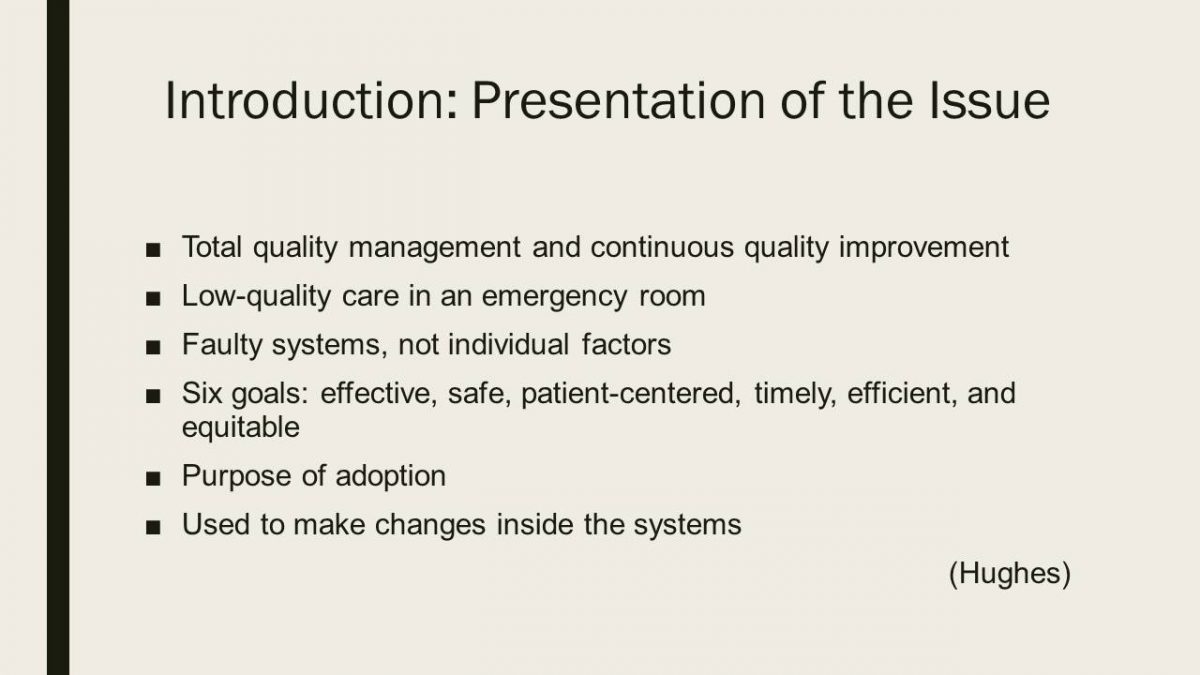
Total Quality Management (TQM): Definition and Objectives
- Definition of TQM.
- Authorizes clinicians to analyze the process.
- Determines customer’s preferences as primary quality assessment factors.
- Expands professional lines.
- Provides motivation and encouragement.
- Utilizes powerful cooperation.
Before covering specific implications of TQM and CQM, it is worthy to examine definitions and objectives of the two strategies separately. As defined by Balasubramanian, TQM is a comprehensive strategy allowing personnel to learn and utilize quality methods for lower expenditures and higher satisfaction of patients. As a management method, TQM has 3 distinguishing functions. First, it authorizes clinicians to analyze the process. Second, it determines customer’s preferences as primary quality assessment factors. Third, it expands the professional lines to provide motivation and encouragement through powerful cooperation.
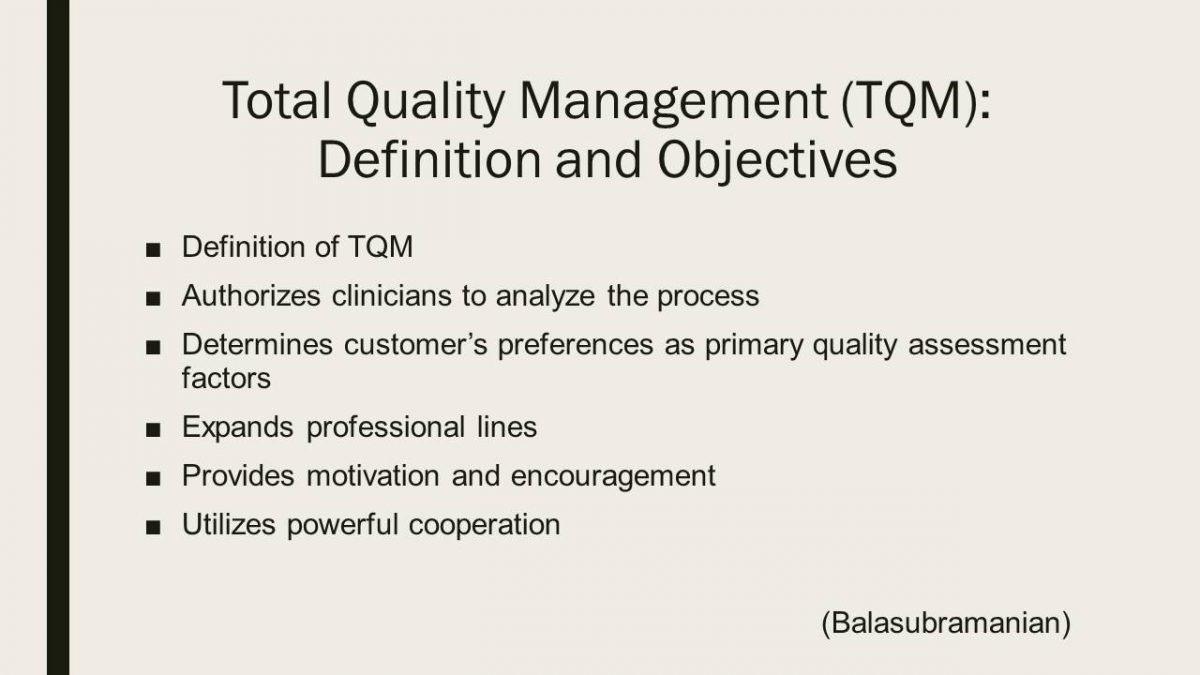
Continuous Quality Management (CQM): Definition and Objectives
- Definition of CQM (Kunkel).
- Define patients’ needs/wants.
- Measure performance.
- Analyze data.
- Improve performance.
- Control by issuing protocols.
Unlike TQM, as mentioned by Kunkel, CQI attempts to improve healthcare by identifying and monitoring issues, with the purpose of executing changes to analyze their effectiveness. Six Sigma, one of the CQI methods, is built around five key terms. According to Van den Heuvel, first, healthcare professionals should define the needs and wants of the patients. Second, they need to measure the performance of healthcare in response to the improvements. Third, it is necessary to analyze data collected. Then, the performance should be modified with regard to the analyzed measurements. In the end, the newly introduced policies should be controlled through the introduction of related protocols.
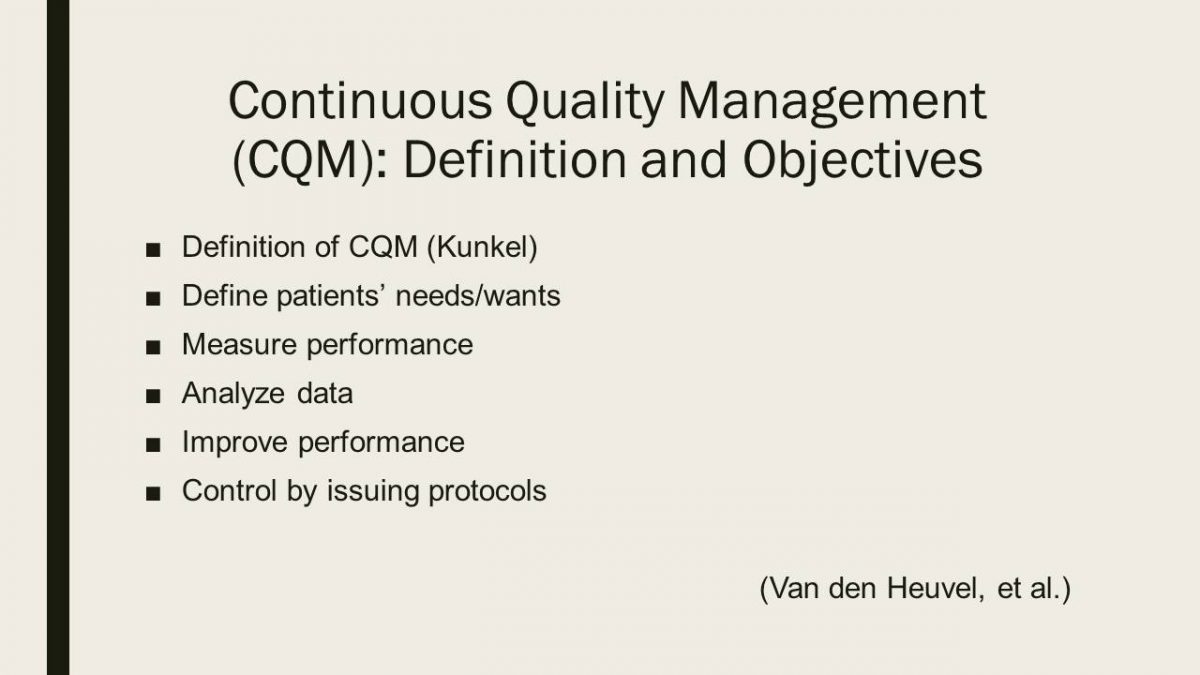
Similarities Between TQM and CQI
- Involve planning and implementing continuous quality improvements.
- Non-stop improvement, customer focus.
- Structured, systematic processes.
- Wide participation in the organization.
- Data-related tools.
- Increased revenues, improved morale, higher customer satisfaction.
For a high number of similarities, many experts do not put a distinctive line of differentiation between CQI and TQM. As suggested by Evans, while CQI is a broader term of TQM, both methods involve planning and implementing continuous quality improvements. Other common factors include non-stop improvement, customer focus, structured, systematic processes, and wide participation of all members of the organization. Furthermore, neither TQM nor CQI can be successfully utilized without data-related tools. At its core, both models aim at increased revenues, improved morale, and higher customer satisfaction.

Differences Between TQM and CQI
TQM:
- continuous effort.
- maintains existing standards of quality.
- maintains high quality standards within the organization’s policies and procedures.
- no extensive training.
- based on company’s vision.
- less accurate and result oriented.
CQI:
- a series of non-related managerial interventions.
- makes little changes to the system to increase performance.
- minimizes and eventually eliminates defects from the systems.
- well-trained, certified professionals.
- based on customer’s feedback.
- more accurate and result oriented.
Despite many shared factors, TQM and CQI are not synonymous, as summarized from the works of Koning and Kunken. First, TQM is based on the continuous effort while Six Sigma introduces a series of non-related managerial interventions. Second, TQM tries to maintain existing standards of quality while Six Sigma makes little changes to the system to increase performance. Third, TQM is primarily concerned with maintaining high quality standards within the organization’s policies and procedures whereas Six Sigma minimizes and eventually eliminates defects from the systems.
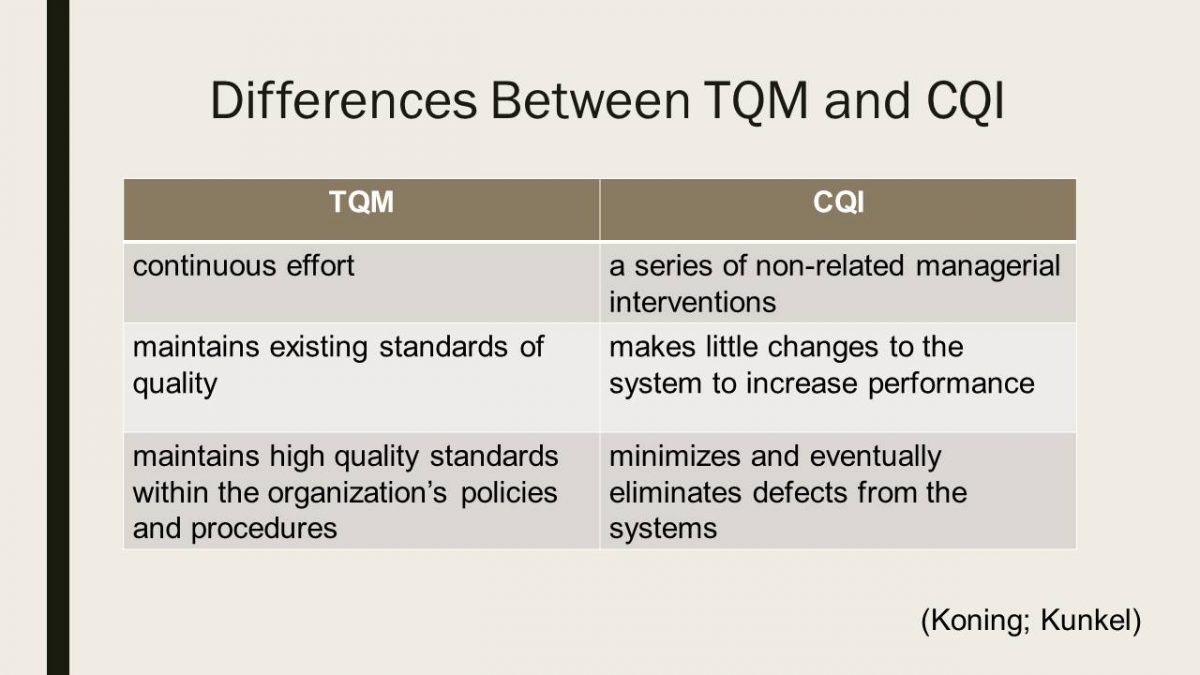
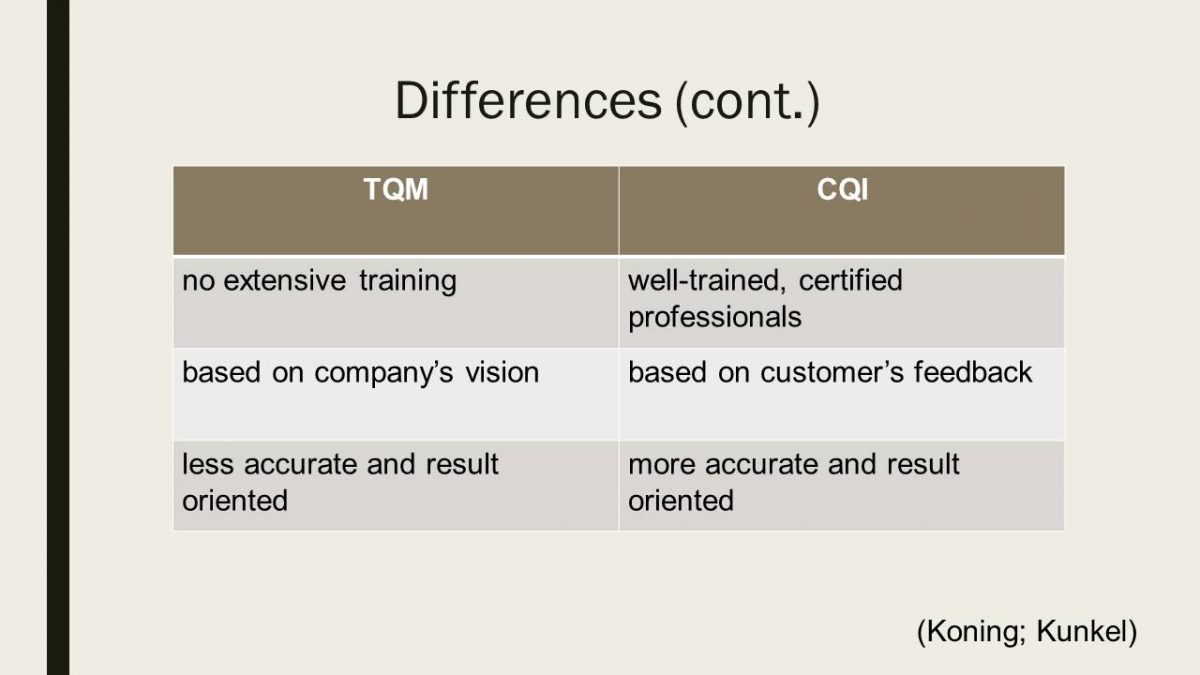
Implications of TQM in Emergency Room
- Waiting time.
- Physicians’ conduct.
- Response for patients’ questions and needs.
- Duration of the examination time.
- Timing of the nursing service.
- Conduct of the nursing staff.
There exist numerous implications of TQM in the context of emergency rooms. As highlighted by Patel, hospital should focus on the existing procedures and policies in ERs to increase patients’ level of happiness. To increase the quality of physicians’ service, managers should implement the method to evaluate overall patients’ satisfaction for the waiting time, physicians’ conduct, response for patients question and needs, and duration of the examination time. In terms of nursing service, TQM can be utilized to assess the timing of the nursing service, conduct of the nursing staff, and overall satisfaction with the help in ER.
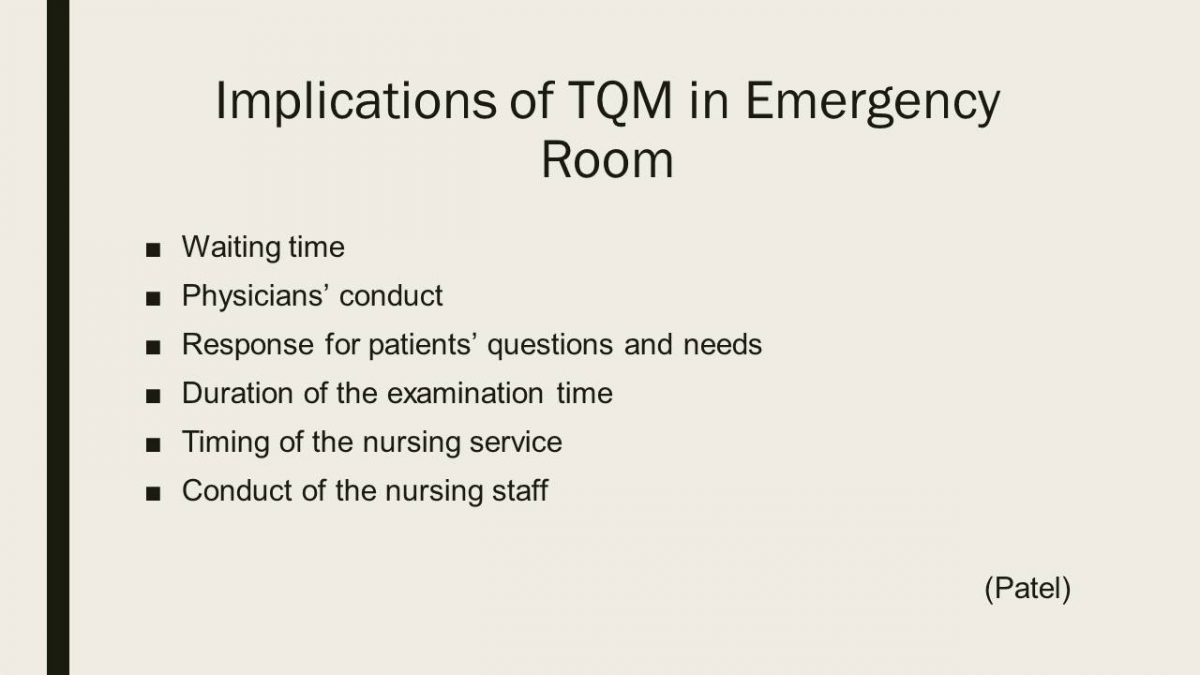
Recommendations on Using TQM
- Continuous improvement, customer satisfaction, and involvement.
- Long-term commitment.
- Consistent training.
- Effective communication.
- Direct focus on the patient.
- Recognition and rewards.
To use TQM effectively, healthcare professionals should adhere to several established guidelines. As further supported by Spath, the three key features of TQM include continuous improvement, customer satisfaction, and involvement of everyone. To satisfy these criteria, managers should engage all employees in long-term commitment through consistent training. With the help of effective communication, healthcare professionals should focus directly on the patient. Productive performance should be recognized and rewarded by top managers. Another important aspect of TQM is the role of top managers in the process of continuous improvement. Instead of positioning themselves as authority, they should provide encouragement and example of supportive leadership.
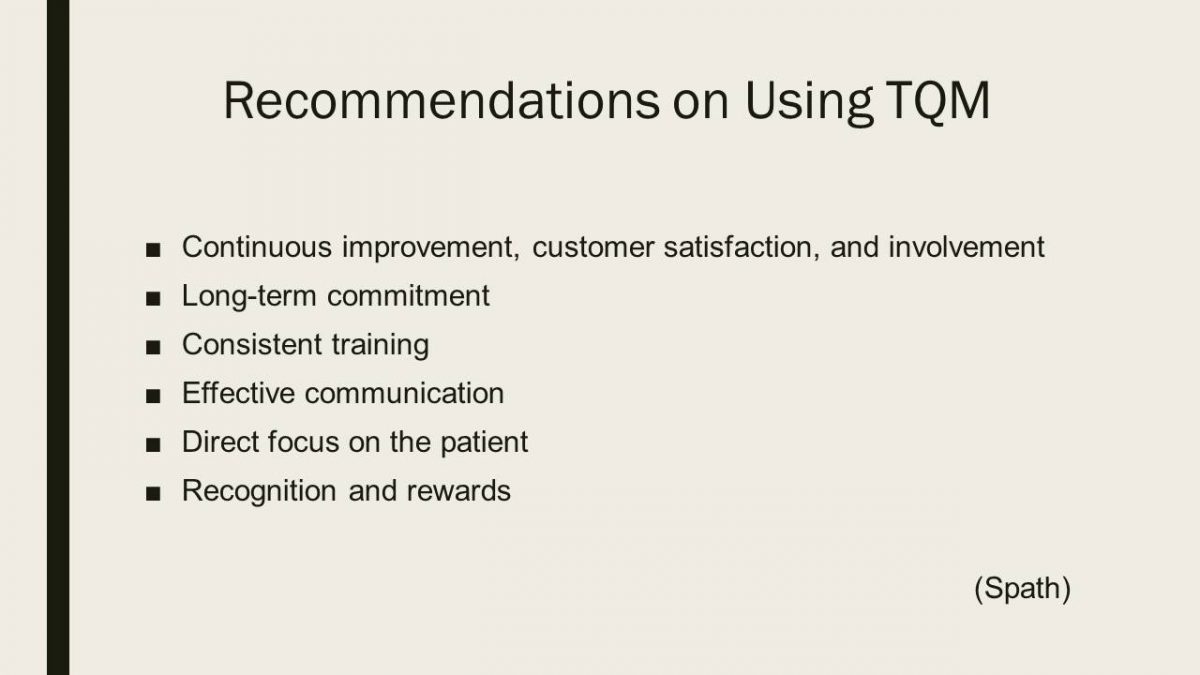
Implications of CQI in Emergency Room
- Evaluation of “fast tracks” for low-complexity patients prior to admissions.
- Reduces the rate of overcrowding in ER corridors.
- Enhances the usage of time-intervals indicators.
- Identifies discrepancies in job descriptions, organization charts.
- Minimizes defects in orientation manuals and physical facilities.
Similarly to TQM, CQI has a broad array of implications in the context of emergency rooms. As noted by Tosic, CQI programs, based on Lean Six Sigma concepts, proved to be effective in evaluating “fast tracks” for low-complexity patients prior to admissions. Six Sigma also reduces the rate of overcrowding in ER corridors and enhances the usage of time-intervals indicators. Other examples of CQI interventions include identifying discrepancies in staff job descriptions, ER organization charts, orientation manuals, and physical facilities.
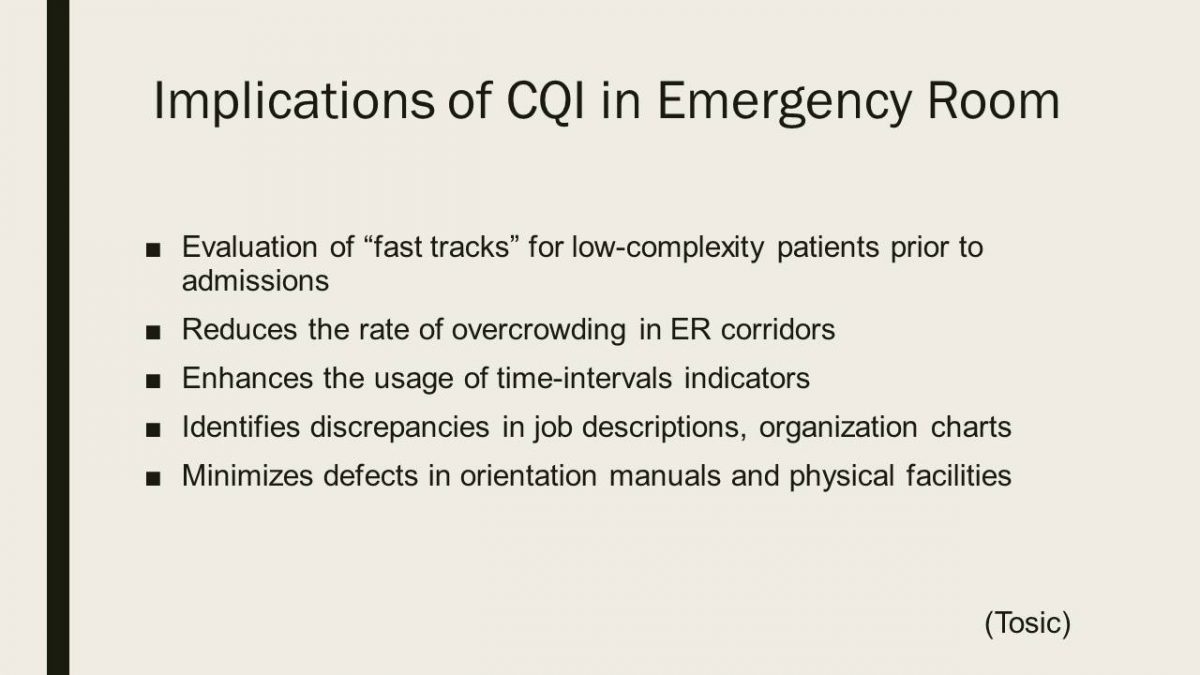
Recommendations on Using CQI
- Define value from patients’ viewpoint.
- Outline each step (both value and non-value based).
- Improve the workflow by sticking to the outlined steps.
- Adjust the steps in response to customer’s feedback.
- Eliminate non-value based activities.
Successful usage of CQI depends on the following five principles. First, managers should define value from patients’ viewpoint, expressing it in terms of a particular project. Second, it is necessary to outline each step necessary for healthcare service, both value and non-value based. Third, healthcare professionals should improve the workflow by sticking to the outlined steps. Then, the steps should be adjusted in response to customer’s feedback. Finally, non-value-based activities should be eliminated from the process, allowing to focus on the patient-centered model of healthcare.
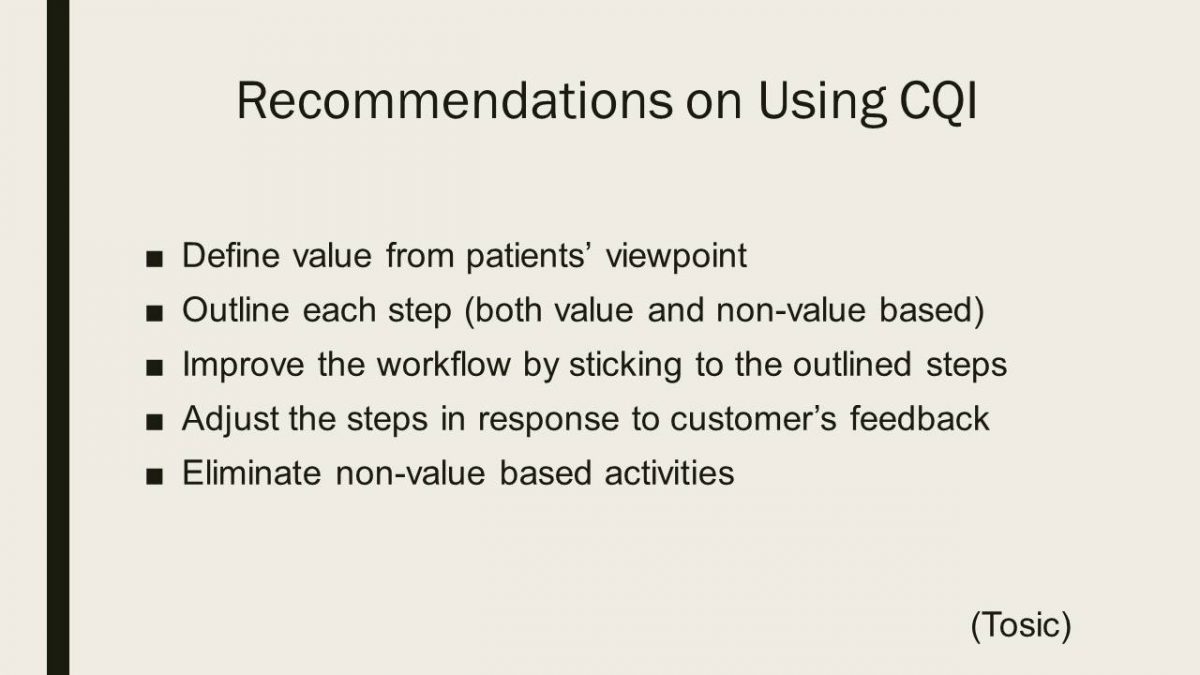
What is a Better Team Strategy?
- No right answer.
- Significant, long-lasting resources and time commitment.
- Six Sigma: more tangible and long-lasting results.
- Predicted superiority of CQI.
There is no right answer when it comes to the evaluative comparison of CQI and TQM. As mentioned in “Science for Improvement: How to Improve,” both methods require significant, long-lasting resources and time commitment both from managers and healthcare professionals. However, the analysis of the recent results in the field suggests that Six Sigma is capable to transform entire processes, showing more tangible, long-term results than TQM. While the statement regarding TQM’s short-lived successes may be limited in its nature, empirical evidence presented across the number of studies, discussed previously in this presentation, predicts the superiority of CQI method.
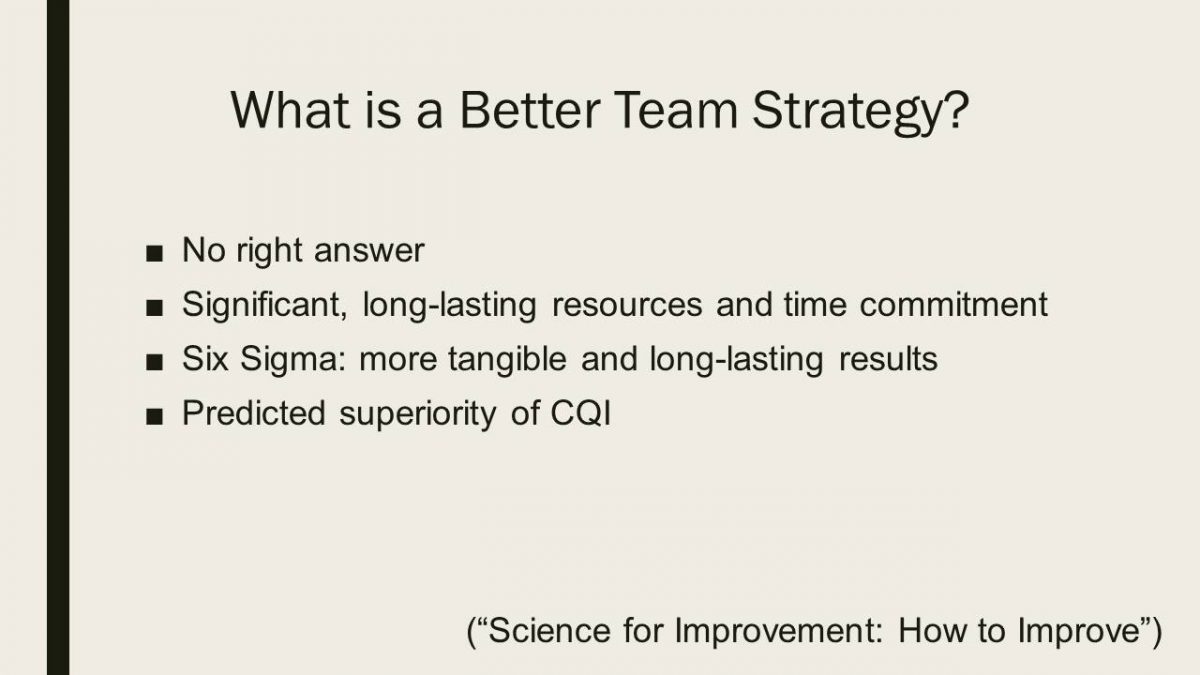
Conclusion: Significance of the Issue
- Thesis restated.
- Mistakes in diagnoses, faulty treatments, and repeatable hospital admissions.
- Complications after the recovery and higher mortality rates.
- Comprehensive approach to the performance assessment.
In today’s presentation, I briefly discussed similarities and differences between TQM and CQI in the context of emergency rooms. Low-quality of care in ERs may lead to higher number of mistakes in diagnoses, faulty treatments, and repeatable hospital admissions. On a global scale, such incidents result in complications after the recovery or even higher mortality rates. To reduce such instances, healthcare managers should incorporate team strategies for effective quality measurement and evaluation which would allow to detect and minimize errors in the system, adhering to high-quality standards. Reasonable usage of TQM and CQI provides a comprehensive approach to the performance assessment.
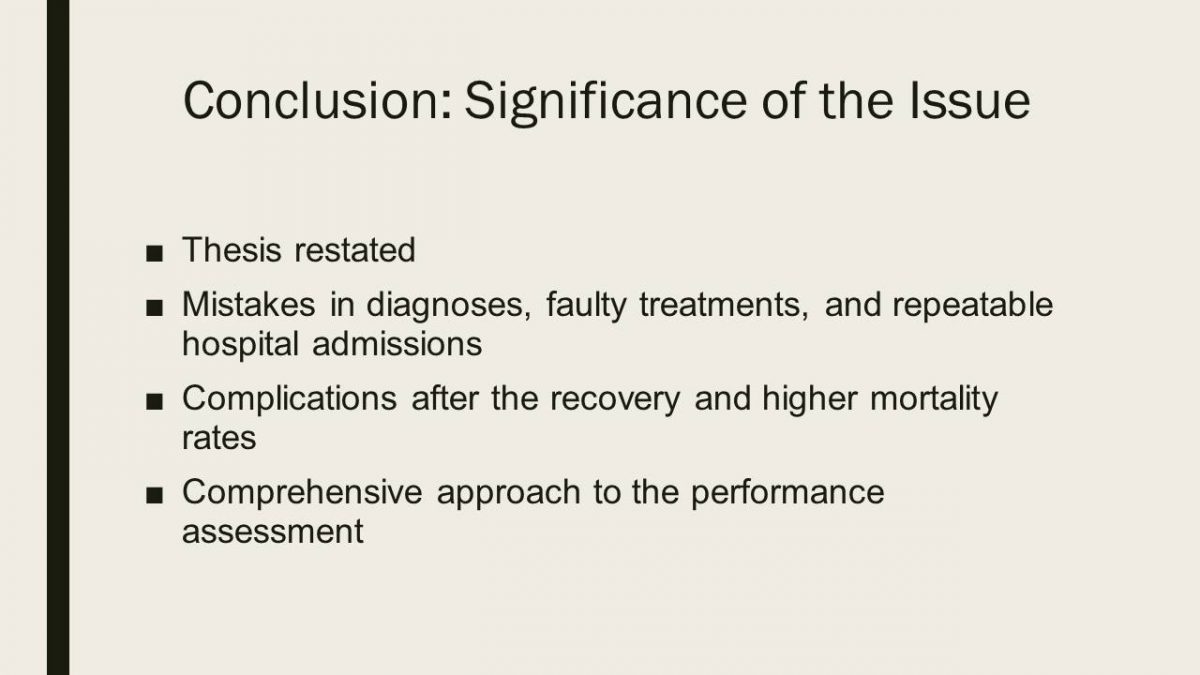
Bibliography
Balasubramanian, Murali. “Total Quality Management [TQM] in the Healthcare Industry – Challenges, Barriers and Implementation Developing a Framework for TQM Implementation in a Healthcare Setup.” Science Journal of Public Health, vol. 4, no. 4, 2016, pp. 271-278. doi: 10.11648/j.sjph.20160404.11
Evans, James Robert, and William M. Lindsay. The Management and Control of Quality. 8th ed., South-Western College Publication, 2011.
Hughes, Robert Graham, editor. “Tools and Strategies for Quality Improvement and Patient Safety.”Patient Safety and Quality: An Evidence-Based Handbook for Nurses. Agency for Healthcare Research and Quality, 2008, pp. 1-18.
Koning, Hank, et al. “Lean Six Sigma in Healthcare.” Journal for Healthcare Quality, vol. 28, no. 2, 2006, pp. 4-11.
Kunkel, Stefan. Quality Management in Hospital Departments: Empirical Studies of Organisational Models. PhD Dissertation, Acta Universitatis Upsaliensis, 2008.
Patel, Gunjan. “Total Quality Management in Healthcare.”The MIDAS Journal – Medical Imaging and Computing, 2009.
“Science for Improvement: How to Improve.” Institute for Healthcare Improvement, 2011. Web.
Spath, Patrice L. Introduction to Healthcare Quality Management. 3rd ed., Health Administration Press, 2018.
Tosic, Bilijana, et al. “Quality Management in Healthcare: Concepts, Principles and Standards.” 3rd International Conference on Quality of Life, Center for Quality, Faculty of Engineering, University of Kragujevac, 2018.
Van den Heuvel, Jaap, et al. “Lean Six Sigma in a Hospital.” International Journal of Six Sigma and Competitive Advantage, vol. 2, no. 4, 2006, pp. 377-388.